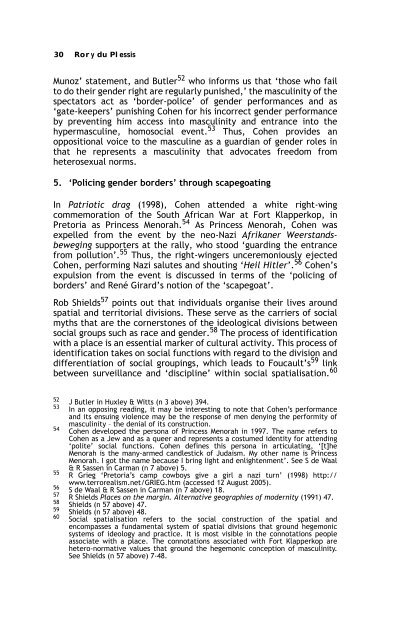Sex, Gender, Becoming - PULP
Sex, Gender, Becoming - PULP
Sex, Gender, Becoming - PULP
Create successful ePaper yourself
Turn your PDF publications into a flip-book with our unique Google optimized e-Paper software.
30 Rory du Plessis<br />
Munoz’ statement, and Butler 52 who informs us that ‘those who fail<br />
to do their gender right are regularly punished,’ the masculinity of the<br />
spectators act as ‘border-police’ of gender performances and as<br />
‘gate-keepers’ punishing Cohen for his incorrect gender performance<br />
by preventing him access into masculinity and entrance into the<br />
hypermasculine, homosocial event. 53 Thus, Cohen provides an<br />
oppositional voice to the masculine as a guardian of gender roles in<br />
that he represents a masculinity that advocates freedom from<br />
heterosexual norms.<br />
5. ‘Policing gender borders’ through scapegoating<br />
In Patriotic drag (1998), Cohen attended a white right-wing<br />
commemoration of the South African War at Fort Klapperkop, in<br />
Pretoria as Princess Menorah. 54 As Princess Menorah, Cohen was<br />
expelled from the event by the neo-Nazi Afrikaner Weerstandsbeweging<br />
supporters at the rally, who stood ‘guarding the entrance<br />
from pollution’. 55 Thus, the right-wingers unceremoniously ejected<br />
Cohen, performing Nazi salutes and shouting ‘Heil Hitler’. 56 Cohen’s<br />
expulsion from the event is discussed in terms of the ‘policing of<br />
borders’ and René Girard’s notion of the ‘scapegoat’.<br />
Rob Shields 57 points out that individuals organise their lives around<br />
spatial and territorial divisions. These serve as the carriers of social<br />
myths that are the cornerstones of the ideological divisions between<br />
social groups such as race and gender. 58 The process of identification<br />
with a place is an essential marker of cultural activity. This process of<br />
identification takes on social functions with regard to the division and<br />
differentiation of social groupings, which leads to Foucault’s 59 link<br />
between surveillance and ‘discipline’ within social spatialisation. 60<br />
52 J Butler in Huxley & Witts (n 3 above) 394.<br />
53 In an opposing reading, it may be interesting to note that Cohen’s performance<br />
and its ensuing violence may be the response of men denying the performity of<br />
masculinity – the denial of its construction.<br />
54 Cohen developed the persona of Princess Menorah in 1997. The name refers to<br />
Cohen as a Jew and as a queer and represents a costumed identity for attending<br />
‘polite’ social functions. Cohen defines this persona in articulating, ‘[t]he<br />
Menorah is the many-armed candlestick of Judaism. My other name is Princess<br />
Menorah. I got the name because I bring light and enlightenment’. See S de Waal<br />
& R Sassen in Carman (n 7 above) 5.<br />
55 R Grieg ‘Pretoria’s camp cowboys give a girl a nazi turn’ (1998) http://<br />
www.terrorealism.net/GRIEG.htm (accessed 12 August 2005).<br />
56 S de Waal & R Sassen in Carman (n 7 above) 18.<br />
57 R Shields Places on the margin. Alternative geographies of modernity (1991) 47.<br />
58<br />
Shields (n 57 above) 47.<br />
59 Shields (n 57 above) 48.<br />
60 Social spatialisation refers to the social construction of the spatial and<br />
encompasses a fundamental system of spatial divisions that ground hegemonic<br />
systems of ideology and practice. It is most visible in the connotations people<br />
associate with a place. The connotations associated with Fort Klapperkop are<br />
hetero-normative values that ground the hegemonic conception of masculinity.<br />
See Shields (n 57 above) 7-48.
















